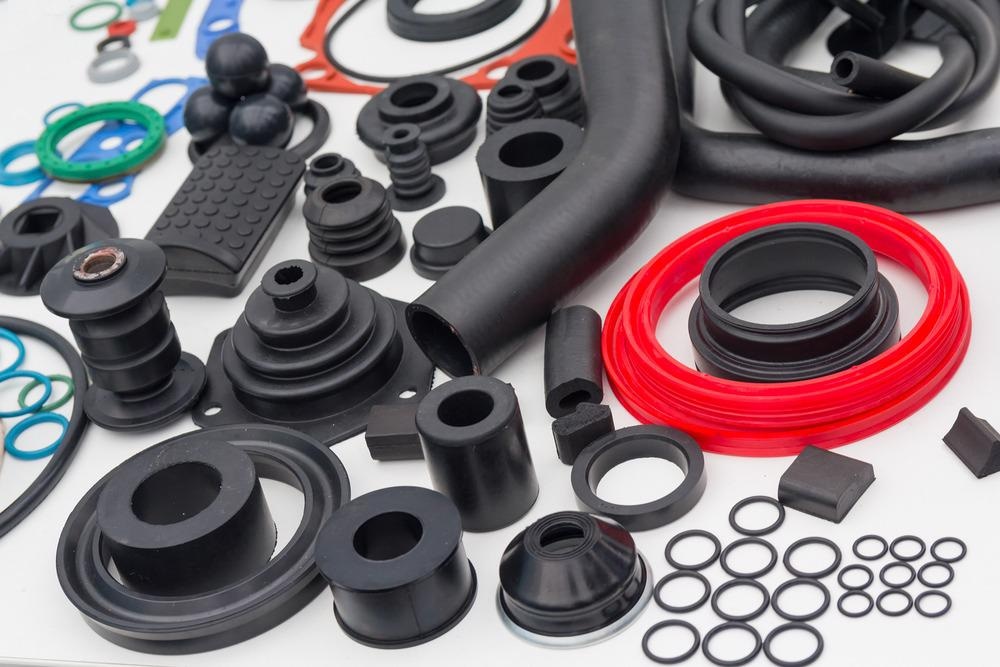An assessment of the extensive operational efficiency of SBR composites suggested that HCNFs@TiO2 hybrids may efficiently augment rubber composites as a novel functional additive in recent research from the journal Materials Chemistryl and Physics.

Study: Nano-TiO2 anchored carbon nanohelices as reinforcing/anti-aging filler for styrene-butadiene rubber. Image Credit: DmyTo/Shutterstock.com
Styrene-Butadiene Rubbers and Fillers
All over the world, concerns regarding ecological degradation and fuel sources as a result of the over-exploitation and overuse of fossil resources have been increasing. The automobile sector has increasingly shifted its focus toward lowering energy use and carbon emissions.
Styrene-butadiene rubber has been widely utilized in tires, adhesives, tubes, cables, and the fabrication of other rubber goods due to its superior oil tolerance and abrasion resistance.
Among the several styrene-butadiene rubber categories, styrene-butadiene rubber 1500E (abbreviated SBR) is ecologically benign and is mostly used in tires for treads and sidewalls. The tread and sidewall are the tire's major force and susceptibility to ultraviolet (UV) rays. Long-term use will result in tire aging, which will increase the car's gas mileage while decreasing the tire's lifespan.
Many innovative additives, such as carbon materials (graphene nanoparticles, single or multiwalled carbon nanotubes), chemical UV stabilizers (hydroxyphenyl compounds, benzotriazoles), and metal oxides (TiO2 and CeO2), have been introduced to the matrix material to minimize automotive gas mileage and increase the durability of rubber tires.
Owing to the increased complexation frequency of the produced electrons and holes, rutile-TiO2 is thought to have a more stable crystalline structure for UV uptake application than anatase-TiO2. However, due to their tiny diameter, relatively high energy, and dynamic thermodynamic condition, TiO2 nanoparticles are typically challenging to spread in a rubber matrix.
Surface Modification of TiO2 Nanoparticles
Surface morphological alteration of TiO2 nanoparticles has been a widespread method in recent years to increase TiO2 nanoparticle distribution in polymers. In prior work, poly (catechol/polyamine) (PCPA) and 3-trimethoxysilyl propyl methacrylate (KH570) were used to alter TiO2 nanoparticles to increase their tensile, electromagnetic, and electromechanical capabilities.
Another study discovered that surface treatment of TiO2 nanoparticles with a silane coupling agent could result in excellent distribution of TiO2 nanoparticles and greater resistance to UV radiation aging in silicone rubber (SiR) (3-aminopropyl triethoxysilane, KH550).
However, surface treatment adjustment of TiO2 overlooks the compliance and interfacial contact between the additives and the latex polymer network. The distribution of TiO2 can increase and improve the UV tolerance of composite material, especially when employed as rubber filler materials, although it has minimal influence on the material's mechanical qualities. As a result, new tactics for overcoming this disadvantage are urgently needed.
Helical Nanofibers TiO2 Reinforcement
Previous research has shown that helical carbon nanofibers (HCNFs), a new carbon material with a unique helical shape, have the same capability for elastomer augmentation as CNTs and graphene. In this study, HCNFs@TiO2 hybrids were created using a straightforward in-situ technique with butyl titanate (TBOT) as the Ti source.
Covalent bonding and an in-situ approach were used to attach TiO2 nanoparticles (19 nm) to the exterior of helical carbon nanofibers (HCNFs). The obtained HCNFs@TiO2 hybrids were employed in melt-blending to reinforce styrene-butadiene rubber 1500E (SBR).
This augmentation sought to enhance the tensile as well as anti-UV aging characteristics of SBR materials by combining the benefits of HCNFs and TiO2. As a result, the study presented in this paper is intended to give a new technique for creating SBR/HCNFs@TiO2 composites with high overall performance.
Key Findings of the Study
In this work, HCNFs@TiO2 composites were grown in situ and employed as reinforcement material in SBR composites. A sequence of characterizations revealed that covalent bonding produced significant interfacial contacts between HCNFs and TiO2 nanoparticles.
The high distribution of HCNFs@TiO2 hybrids in the SBR material increased the degree of crosslinking, adhesive rubber percentage, and overall tensile characteristics of the SBR hybrids. Ultimate tensile strength and elongation at break of SBR/C@Ti-3 (3 phr HCNFs@TiO2) composite improved 15.0 percent and 25.1 percent, respectively, as compared to SBR/CB (control) composites.
The wet-slip characteristics of the SBR/C@Ti-3 composites were greater, and the rolling resistance was lower. Furthermore, the SBR/HCNFs@TiO2 hybrids outperformed the SBR/CB materials in terms of anti-UV aging resilience, with maintained tensile strength and elongation at a break that was 1.9 and 3.3 times greater, respectively, than the SBR/CB composites.
This research demonstrates a novel method for improving the distribution of TiO2 nanoparticles and investigates the use of multipurpose composite additives in high-performance tires.
Reference
Li, Y. et. al. (2022). Nano-TiO2 anchored carbon nanohelices as reinforcing/anti-aging filler for styrene-butadiene rubber. Materials Chemistry and Physics. Available at: https://www.sciencedirect.com/science/article/pii/S0254058422004254?via%3Dihub
Disclaimer: The views expressed here are those of the author expressed in their private capacity and do not necessarily represent the views of AZoM.com Limited T/A AZoNetwork the owner and operator of this website. This disclaimer forms part of the Terms and conditions of use of this website.